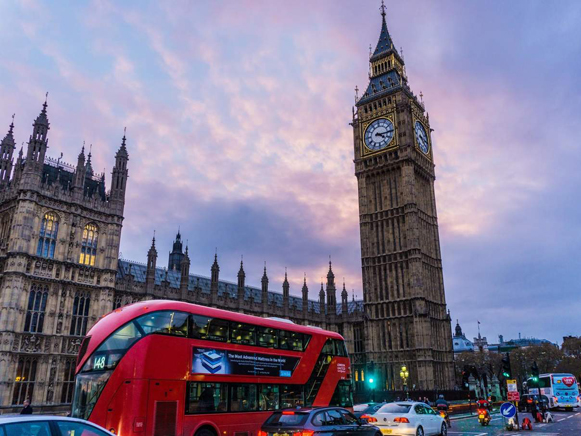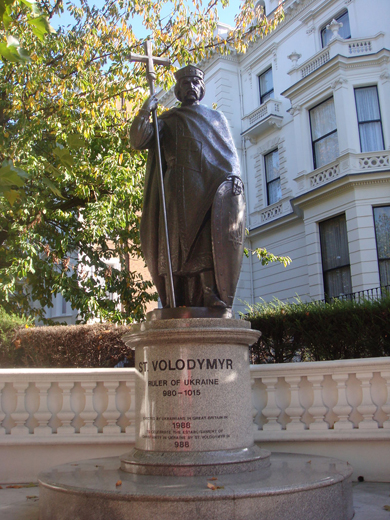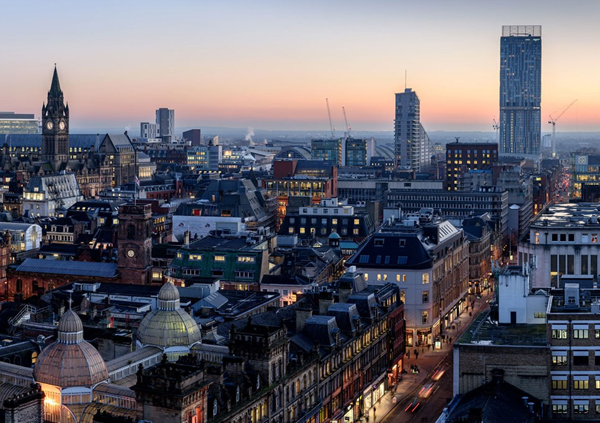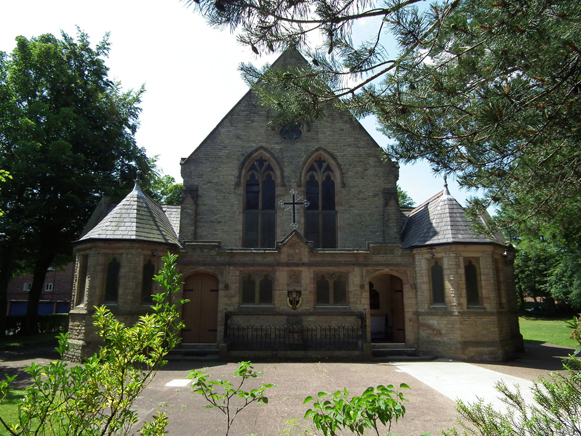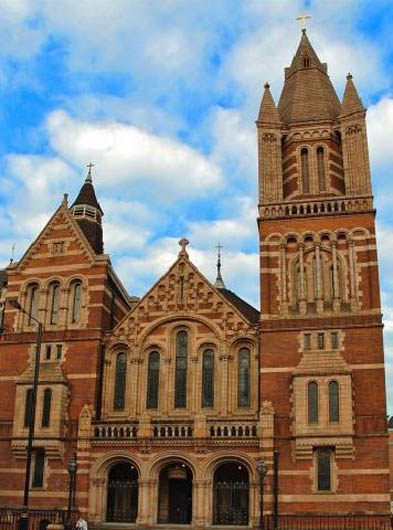Great Britain
Great Britain (official name: United Kingdom of Great Britain and Northern Ireland). A constitutional monarchy, its territory covers 209,331 sq km, and its population in 2011 was 60,800,000, including over 30,000 Ukrainians. The capital is London.
Ukrainian-British contacts. At first, relations between Ukraine and Great Britain were sporadic. According to the sagas, after Canute’s conquest of England in 1016 the sons of the English king Edmund II found refuge in Kyiv. Gytha, the daughter of King Harold II, was married to Grand Prince Volodymyr Monomakh and brought an English retinue with her to Kyiv. Besides dynastic ties, there was some trade between the two countries. In the 12th century a Scottish monastery and church were built in Kyiv. For the next few centuries, however, British-Ukrainian relations were interrupted. In the 15th century grain and lumber began to be exported via the Baltic Sea from Ukraine to Britain. At the beginning of the 17th century the noble Yurii Nemyrych studied at Oxford and Cambridge.
In the 17th century English readers began to take an interest in the Cossacks, receiving much of their information through the English legation in Turkey. R. Knolles, in his The Generall Historie of the Turks (1603), described Cossack naval expeditions on the Black Sea. English official circles were especially interested in the Cossacks as potential allies in their conflict with the European Catholic states, including the Polish-Lithuanian Commonwealth, in the early 17th century. Newspapers such as Mercurius Politicus, London Gazette, The Moderate Intelligencer, and Several Proceedings informed the English public about developments in Ukraine under Hetman Bohdan Khmelnytsky and subsequent hetmans. The diary of P. Gordon, a Scottish general of the Russian army, contained much interesting information about Ukraine. Other early sources of information about Ukraine included E. Browne’s translation of Pierre Chevalier’s Histoire de la guerre des Cosaques contre la Pologne titled A Discourse of the Origin, Countrey, Manners, Governement and Religion of the Cossacks ... (1672), P. Heylyn’s world geography (1666), A. Tyler’s Memoires of John the Great ... Present King of Poland ... (1685), Fr.- P. Dalairac’s Les Anecdotes de Pologne (English edn 1700), and J. Crull’s The Ancient and Present State of Moskovy ... (1698). A collection of letters by the personal physician to the Polish king Jan III Sobieski, B. Connor, to various English dignitaries was published in 1690 as The History of Poland ... One of these letters, to William, Duke of Devonshire and Lord Steward, contained an especially detailed description of Ukraine and the Cossacks.
In the 18th century Peter I’s victory over Charles XII of Sweden and Hetman Ivan Mazepa at the Battle of Poltava (1709) again aroused the British public’s interest in Ukraine. British diplomats and envoys, who were alarmed by the growth of Russian power, followed closely developments in Ukraine, and especially Ukrainian independence sentiments. Pylyp Orlyk, the émigré hetman of Ukraine, maintained contacts with British government circles. A translation of Guillaume Le Vasseur de Beauplan’s Description d’Ukranie, published in J. Churchill’s collection of travel accounts (1704), was widely read. J. James, Joseph Marshall, Edward Daniel Clarke, and others wrote descriptions of Ukraine in the 18th and early 19th century. Lord Byron’s romantic tale Mazeppa: A Poem (1819) did much to popularize the famous hetman in the 19th century. At the end of the 18th century the British government defended non-Catholics who were being persecuted in the Polish Commonwealth.
In the 1860s British economic ties with Ukraine expanded. The New Russia Ironworks Company (est 1870), founded by J. Hughes and funded mostly by British capital, provided strong competition for Belgian, French, and Russian companies. In the 1870s it established a metallurgical plant in Bakhmut county, which used Donbas coal to process iron ore brought in from Kryvyi Rih (see Kryvyi Rih Iron-ore Basin). By the turn of the century it was one of the largest providers of iron and metal products for both the imperial Russian economy and for export. Meanwhile, in Galicia several petroleum consortiums were organized to exploit the resources in the Drohobych-Boryslav Industrial Region: the Anglo-Austrian Society in Tustanovychi (est 1906), the Anglo-Polish Trade Society (est 1908), and the English Stock Company in Lviv (est 1912). From 1904 Roman Zalozetsky-Sas acted as honorary British consul in Lviv. Around the turn of the century Britain was a major consumer of Ukrainian grain and sugar (as much as one-third of all Ukrainian exports of the latter), as well as of substantial quantities of livestock and iron ore.
In the second half of the 19th century English works on Ukrainian folklore and literature began to appear in print; eg, William Morfill’s articles on Taras Shevchenko, Ethel Lillian Voynich’s collection of Shevchenko translations (1911), and later works by R. Seton-Watson, A. Toynbee, W. Napier, and C. Macartney. The journal Athenaeum published some articles and reviews of Ukrainian subjects, including a description of the Kyiv-based Southwestern Branch of the Imperial Russian Geographic Society by Mykhailo Drahomanov. Between 1912 and 1915 George Raffalovich (pseudonym: Bedwin Sands), a Jew from Ukraine, advocated Ukrainian independence in his numerous journalistic writings until he was forced to leave Great Britain, having been accused of pro-German sympathies. Raffalovich also translated Mykhailo Hrushevsky’s The Historical Evolution of the Ukrainian Problem (London 1915). After the Second World War William Matthews, a Slavist, and the historian H. Seton-Watson published studies on Ukraine.
The attitude of the British government to Ukrainian independence was reserved, but not hostile. In December 1917 John Picton Bagge was sent to Kyiv to represent Great Britain in the Ukrainian National Republic. The Directory of the Ukrainian National Republic sent a diplomatic mission to Great Britain—headed by Mykola Stakhovsky and then by Arnold Margolin and Yaroslav Olesnytsky—but it did not receive official recognition from Great Britain. The mission of the Western Ukrainian National Republic also was not formally recognized. The work of these missions was limited to informing the British public about Ukrainian affairs and to preparing several memorandums. The British government actively supported the White armies of generals Anton Denikin and Petr Wrangel.
During the Paris Peace Conference various solutions to the problem of eastern (Ukrainian) Galicia were considered by the British government, including its incorporation into Czechoslovakia or a non-Bolshevik Russia and its inclusion as an autonomous territory in the Polish state. The Curzon Line, which was proposed by the British foreign secretary, Lord G. Curzon, was adopted by the Allied Supreme Council as Poland’s eastern border, and after the Yalta Conference (1945) it became the basis of the Polish-Ukrainian border.
During the interwar period protests against anti-Ukrainian policies of the Polish authorities were often voiced in Britain. The British press, and particularly the Manchester Guardian, criticized the so-called Pacification. An objective report on the campaign by M. Sheepshanks, the general secretary of the International Women’s Union who visited eastern Galicia immediately after the Pacification, appeared in the Manchester Guardian Weekly. The British consul in Warsaw spent much of the autumn of 1930 in Lviv, keeping his government informed of events in Galicia. On 5 October 1932 a group of 32 MP’s and five members of the House of Lords submitted the ‘Petition to the League of Nations concerning the Ukrainian Minority in Poland and the Question of the Establishment of an Autonomous Regime in the Territory Known as Eastern Galicia ...’
In 1933 the British government became even more interested in Ukraine. Its missions in Warsaw and Moscow were instructed to follow closely Ukrainian affairs. Malcolm Muggeridge, an English correspondent in Moscow, sent in accurate reports on the Famine-Genocide of 1932–3 in Ukraine. Questions about the famine were raised in the House of Commons. For much of this period Tracy Philipps, the British relief commissioner in ‘South Russia’ in 1921, was one of the more influential British officials who was knowledgeable about Ukrainian affairs.
From 1932 to 1939 Vladimir Kaye-Kysilewsky directed the Ukrainian Bureau in London, which was financed by Yakiv Makohin. In 1933–5 Yevhen Liakhovych acted as the representative of the Organization of Ukrainian Nationalists in London and in the late 1930s the Ukrainian Canadian S. Davidovich ran the Ukrainian Information Bureau there. A group of Hetmanite supporters published The Investigator, an English-language information bulletin edited by Volodymyr Korostovets.
In 1935 the Anglo-Ukrainian Committee was formed in London to promote the cause of Ukrainian independence. Its members included Lord Dickinson, Mrs Dugdale, G. Gooch, L. Lawton, F. Lincoln, C. Macartney, Col C. L’Estrange Malone, G. le M. Mander, Sir W. Napier, and M. Sheepshanks.
After the Second World War the British government supported the Soviet annexation of Galicia. In a House of Commons debate on 21 February 1945, A. Eden argued that the annexation would strengthen Ukraine’s political and ethnic unity. In 1947 and 1950 the British government tried to establish diplomatic relations with the Ukrainian SSR, but it could not gain the approval of the Soviet authorities in Moscow.
In the 1950s the Scottish League for European Freedom in Edinburgh, headed by D. Stewart, maintained close ties with the Anti-Bolshevik Bloc of Nations and the OUN (Bandera faction), and in its publications supported the idea of Ukrainian independence. A number of English politicians were members of the Anglo-Ukrainian Society, which was organized by Auberon Herbert. In 1951 some House of Commons members proposed that a Ukrainian radio program on the BBC be established, but failed to win majority support. In the 1960s the Anglo-Ukrainian Mazeppa Society was founded.
Ukrainians in Great Britain. There were a few Ukrainians in Great Britain before 1939: members of diplomatic missions from the period of Ukrainian independence, a group of political émigrés, and a small number of students. There was also a community of Ukrainian workers in Manchester, who in 1893 on their way to North America had decided to stay in England. By 1912 the community numbered 500. Most of them emigrated to the United States before the outbreak of First World War in 1914. Those who remained worked mostly as tailors and had their own Ukrainian Club (est 1929). After the fall of France in 1940 some Ukrainian soldiers in the Polish army went to England. During the Second World War a representative of the Government-in-exile of the Ukrainian National Republic, Volodymyr Solovii, was active in London. Danylo Skoropadsky, a leader of the Hetmanite movement, lived in London during the war.
Ukrainians appeared in Britian in larger numbers during and immediately after the war. Among them were soldiers of the Canadian armed forces and of the Polish army, some of them evacuated from France but most (about 6,000 members of Gen Władysław Anders’s Polish Second Corps) brought in from Italy. The first Ukrainians in the Division Galizien (eventually totaling 8,361 men) arrived as contract laborers in Britain from the British prisoner of war camp in Rimini, Italy in April 1947. In June the so-called European Voluntary Workers who were recruited by special commissions in the British zones in Germany and Austria began to arrive; within two years 21,000–24,000 Ukrainians, including about 5,000 women, came in under this classification. People with higher education were not admitted, and elderly people were accepted very reluctantly. About 2,000 Ukrainian women from Yugoslavia and Poland were admitted in subsequent years on invitation from prospective husbands. Ukrainian men married Italian, German, and Irish women, but rarely English women. At the beginning of the 1950s Ukrainians began to emigrate from Britain to North America. Eventually, 8,000–10,000 individuals left.
Ukrainian veterans of the Polish army were treated on a par with Poles and Englishmen; they had a free choice of occupation and residence. Members of the Division Galizien, however, continued to be treated as prisoners, living in hostels and working as farm laborers; only at the end of 1948 and the beginning of 1949 were they freed from their obligations and restrictions and allowed to work and live where they desired. The European Voluntary Workers were contracted for three years of regimented labor on farms, in textile factories or coal mines, as hospital orderlies, or as domestic help, after which they too became free workers. All foreign workers received the same wages as British workers. Ukrainians tended to move from the farms into the cities, taking jobs as unskilled labor in transport (railways and buses) and the textile, coal, and construction industries. Many with some secondary education tried to upgrade their education to qualify for a white-collar job. Women tended to work as nurses. Ukrainians of the younger generation (born in Britain) usually did not attend university and were satisfied with a secondary education and vocational training. A large proportion of them, particularly women, worked as teachers or as office clerks. Only a few (600–800) have completed university studies and become professionals. In 1983 Stefan Terlezki, a Ukrainian, was elected as a Conservative to the House of Commons.
The overwhelming majority of Ukrainians in Britain (75–80 percent) own their own homes, and 5–7 percent own more than one house. Relatively few postwar immigrants—usually only those with some education—have applied for British citizenship; Ukrainians born in Britain have become citizens automatically. In general, Ukrainians have a good reputation among the British: they are believed to be thrifty, enterprising, hard working, and conscientious. They are also quick to attain a decent standard of living. Two-thirds of Ukrainian immigrants in Britain are Galicians; the rest come from other parts of Ukraine.
The territorial distribution of Ukrainians in Britain has changed dramatically. Immediately after the Second World War, about 10,000 Ukrainians lived in Scotland, but by 1980 at most 1,000 remained there. There are almost no Ukrainians in northern Wales or in Northern Ireland, and only 250–300 in southern Wales. Ukrainians are concentrated mostly in London and in central England—in Manchester and vicinity (Rochdale, Bolton, Bury); in the textile region of Leeds, Bradford, Halifax, and Huddersfield; in the heavy-industry region of Birmingham, Coventry, and Wolverhampton; and in Nottingham and Leicester. In 1985 there were about 1,500 Ukrainians in London, 2,000 in Nottingham, 2,000 in Bradford, and 4,000 in metropolitan Manchester.
Religion. Of the 30,000 Ukrainians in Great Britain in 1985, 3,500–4,000 were Ukrainian Orthodox, 21,000–22,000 were Ukrainian Catholic, and the rest belonged to other denominations or to none at all.
The first Ukrainian priests were chaplains of the Canadian armed forces—Rev Semen Sawchuk (Orthodox) and Rev M. Horoshko (Catholic)—who arrived in the summer of 1944. In 1946 Rev Josaphat Joseph Jean of the Basilian monastic order was sent from Canada. Ukrainian Catholics in Britain came under the jurisdiction of the apostolic visitator of Ukrainians in Western Europe. From the end of 1946 this office was held by Bishop Ivan Buchko, who visited England in early 1947 and, with the co-operation of the British hierarchy, established the organizational structure for Ukrainian Catholics. Rev J. Jean, who later became general vicar, was appointed to the London parish and assigned eight priests (four former chaplains of the Division Galizien, two former chaplains of Władysław Anders’s Polish Second Corps, and two priests sent from Rome) to serve all of Britain. The first church was established in London in Saffron Hill, and congregational centers were set up in Manchester, Nottingham, Rochdale, Bradford, Cambridge, and Edinburgh. The arrival of more priests from Germany increased the total number to 17. In 1949 Rev Volodymyr Malanchuk became vicar-general; he was succeeded in 1950 by Rev Oleksander Malynovsky and in 1957 by Rev P. Maliuga. An exarchate (from 1967 an apostolic exarchate), initially headed by the archbishop of Westminster, W. Godfrey, was set up for Ukrainians in 1957. In 1961 he was replaced by Bishop A. Horniak. A large Ukrainian Catholic cathedral was opened in the following year in the Mayfair district of London. In 1985 the exarchate encompassed 16 churches and 13 priests in England and Scotland.
Two priests and their congregations remain outside the jurisdiction of the exarch because of a major controversy that developed in the 1970s between Bishop Horniak and Archbishop Major Yosyf Slipy over the problem of a Ukrainian Catholic patriarchate. They formed first the Central Committee for a Ukrainian Catholic Patriarchate and then the Ukrainian Catholic Patriarchate Lay Association, which in 1985 represented 75 branches and 16 member organizations with about 5,000 members.
Most Orthodox Ukrainians in Britain belonged to the Western European Metropolitanate of the Ukrainian Autocephalous Orthodox church. The first Orthodox congregations arose in the 1940s when about 5,000 Orthodox laymen and a number of priests arrived from Germany as European voluntary workers. An administrative board for England headed by Rev I. Hubarzhevsky and then by Rev S. Molchanivsky was elected. A Ukrainian Orthodox bishop for Great Britain—V. Didovych—was not appointed until 1983. Since 1948 over 30 priests have ministered to the Ukrainian Orthodox in England. In the 1980s there were eight priests and two deacons. There were five Orthodox churches but 18 parish centers. Parishes that do not have their own churches conduct services in Anglican churches. In 1977 a Ukrainian Orthodox cathedral, religious center, and episcopal residence were established in London.
In the 1960s and 1970s a small number of Orthodox Ukrainians belonged to the Ukrainian Autocephalous Orthodox Church (Conciliar), which was led by Rev I. Hubarzhevsky. A number of congregations of the All-Ukrainian Evangelical Baptist Fellowship are still active in Britain.
Civic and political organizations. During the Second World War the Ukrainian Canadian Servicemen's Association was established in London. It, in turn, organized the Central Ukrainian Relief Bureau to assist the displaced persons in Europe. In January 1946 the Association of Ukrainians in Great Britain (SUB) was organized, mostly by Ukrainian soldiers of the Polish army. By the beginning of 1947 its membership numbered 1,430. As the influx of refugees from Europe increased, SUB membership grew rapidly and by 1949 reached 22,000. A power struggle within the association culminated in the victory of the OUN (Bandera faction) at the convention of March 1949, and the secession of the defeated minorities, who formed the Federation of Ukrainians in Great Britain. This schism in the Ukrainian community of Great Britain has had a decisive influence in almost all facets of community life.
SUB remains the largest Ukrainian organization in Britain: almost 27,000 people have passed through its ranks. At the end of 1984 it had 58 branches, 12 local chapters, and a membership of 16,700. Other important organizations include the Ukrainian Former Combatants in Great Britain, which in the 1950s had a membership of 4,000 and in 1986 still had 1,740 members and 50 branches; the OUN (Bandera faction)’s Ukrainian Youth Association (est 1948), which once claimed a membership of close to 5,000 and in 1986 still had about 3,000 members; and the Association of Ukrainian Women in Great Britain, with 2,500–2,800 members. The Plast Ukrainian Youth Association was established in Great Britain in 1950; in 1985 it had 215 members.
Every Ukrainian émigré political party has some sympathizers in Great Britain, but the most numerous and active force consists of supporters of the OUN (Bandera faction). Adherents of this group gained control of most Ukrainian organizations, the press, and economic institutions (several co-operatives) in Great Britain. Supporters of the Hetmanite movement, which had some influence while Danylo Skoropadsky was alive, have collaborated with the Bandera faction. The Federation of Ukrainians in Great Britain is controlled by the OUN (Melnyk faction). In the past the Ukrainian Revolutionary Democratic party, which controlled the Petliura Legion, and the supporters of the Ukrainian National Council, who formed the Ukrainian Association of Great Britain, had some influence in the Ukrainian community. The Ukrainian-Polish Society, of which K. Zelenko is copresident, had a membership of 190 and was still politically active in the 1980s.
Education. In the immediate postwar years there were few Ukrainian children of school age in Great Britain. Their numbers began to increase from the end of the 1950s as children born in Britain reached school age. Ukrainian schools were organized by the Association of Ukrainians in Great Britain, the Union of Ukrainian Teachers and Instructors (est 1955), and a few other associations. By the mid-1960s there were 45 Ukrainian Saturday schools, with a total enrollment of about 3,000. At the same time there were 15 Ukrainian nurseries with about 200 children. Up to 230 individuals taught in these institutions. Eventually, the number of students and schools declined: by 1984 there were 14 schools with an enrollment of 350. Most teachers now are graduates of Ukrainian Saturday schools. From 1980 the teachers’ union was headed by B. Marchenko.
The number of Ukrainian students attending British post-secondary schools peaked in the 1970s: in 1973 it was over 700. The Ukrainian Student Club at the time had over 100 members. The Ukrainian Graduate Society, whose membership consists of recent graduates of higher schools, conducts cultural and social activities at an academic level. In 1979 a branch of the Ukrainian Catholic University (Rome) was set up in London.
Literature, art, music, and science. There are not many Ukrainian intellectuals or writers in England. Some of the writers who lived there are V. Shaian, S. Fostun (president of the Society of Ukrainian Litterateurs since 1976), and the poets B. Bora (Shkandrii), Halia Mazurenko, and A. Lehit. The English poet Vera Rich translated many works of the Ukrainian literature. Several Ukrainian émigré scholars have worked in England: the archeologist Vadym Shcherbakivsky, the historian Panas Fedenko, the forester O. Paramoniv, the biochemist M. Zakomorny, and the Slavist Victor Swoboda. Well-known artists have included the painters Vasyl Perebyinis, H. Mazurenko, and R. Hluvko; the graphic artists Robert Lisovsky and I. Voloshchak; and the enamelist M. Ladyk.
The best Ukrainian choir in Great Britain is Homin (formerly Burlaka) in Manchester, which won first prize at an international competition in Llangollen, Wales; its conductors have been Ye. Pasika (until 1965) and Ya. Babuniak. The Orlyk dance ensemble, directed by P. Dnistrovyk and M. Babych, has received international recognition. A number of dance and instrumental ensembles are supported by local branches of the Ukrainian Youth Association. The composer Stefaniia Turkevych-Lukiianovych resided and worked in England after the war. Volodymyr Lutsiv, a bandura player and impresario, is also active in Ukrainian musical life.
Publishing. The Ukrainian Publishers Limited was an important publisher for the OUN (Bandera faction) not only in Britain, but in the West as a whole. The firm has published SUB weekly Ukraïns’ka dumka (London), the journals Vyzvol’nyi shliakh, The Ukrainian Review, and Holos molodi, and belletristic and publicistic works. The veterans’ quarterly Surmach still appeared in the 1980s, but the socialist journal Nashe slovo and the monarchist newspaper Ranok were short-lived. A number of religious periodicals have been published in England: the Catholic journal Nasha tserkva (1953–75), the Orthodox Vidomosti Heneral’noho tserkovnoho upravlinnia UAPTs u Velykii Britaniï (since 1950), and the Baptist quarterly Visnyk spasinnia (since 1949). A group of Ukrainian students and graduates known as the Vitrage Society published the journal Vitrazh (1977–83).
General features and prospects. From its beginning the Ukrainian community in Great Britain had some distinctive features: it consisted mostly of young men who had served the cause of Ukrainian independence during the Second World War. Because of their age and political experience, the first generation of emigrants was extremely active, in comparison with other emigrant groups, in community affairs: almost 80 percent of all Ukrainians belonged to Ukrainian organizations and churches. The high degree of political commitment facilitated the dominance of the community by radicals. Furthermore, the religious conflict within the Ukrainian Catholic church had a detrimental effect on the community. As a result of a shortage of Ukrainian women, quite a few postwar immigrant men remained single and the number of mixed marriages was high, making it difficult to maintain the Ukrainian language and culture among the second generation. Consequently a relatively small proportion of young people of Ukrainian origin attended Ukrainian schools and belonged to Ukrainian youth organizations, and the process of linguistic assimilation has advanced quite far.
With the passing of the older generation, the dynamism of the Ukrainian community declined in the 1980s. This was evident from the falling membership of Ukrainian organizations and the declining circulation of the Ukrainian press. And the occupational profile of the Ukrainian community was changing: the younger generation was entering the professions and was advancing beyond its elders in economic status. Those who remain conscious of their ethnic identity continue to participate in community life, which is changing in form and content.
BIBLIOGRAPHY
Borschak, E. ‘Early Relations between England and Ukraine,’ Slavonic Review, no. 28 (1931–2)
Wynar, L. ‘The Question of Anglo-Ukrainian Relations in the Middle of the Seventeenth Century,’ AUA, 7, nos 21–2 (1958)
Nerhood, H. (comp). To Russia and Return: An Annotated Bibliography of Travelers’ English-Language Accounts of Russia from the Ninth Century to the Present (Columbus, Ohio 1968)
Danyliv, T. Kudy ide nasha hromada u Velykobritaniï (Munich 1970)
Zelenko, K. ‘Velykobritaniia i Ukraïna,’ in Ievhen Konovalets' ta ioho doba (Munich 1974)
Petryshyn, R. ‘Ukraïntsi v Velykobritaniï,’ in Ukraïns'ki poselennia: Dovidnyk, ed A. Milianych et al (New York 1980)
———. ‘Britain’s Ukrainian Community: A Study of the Political Dimension in Ethnic Development.’ PH D diss, University of Bristol 1980
Luciuk, L.Y. Heroes of Their Day: The Reminiscences of Bohdan Panchuk (Toronto 1983)
Saunders, D. ‘Aliens in Britain and the Empire during the First World War,’ in Loyalties in Conflict: Ukrainians in Canada during the Great War, eds F. Swyripa and J. Thompson (Edmonton 1983)
Mykhailo Dobriansky-Demkovych
[This article originally appeared in the Encyclopedia of Ukraine, vol. 2 (1988).]
